Today I thought we might review positioning clients and some indications for it. Please keep in mind that you might have an order for a seperate position for your patient then what I have listed below.
Position: Semi-Fowler's
Semi Fowlers is when the head of the bead is elevated to a 30 degree angle. Some reasons for positioning your patients are gastric feedings, head injusy (caution with increased ICP risks), postoperative cranial surgery, respiratory illness with dyspnea, or postoperative cataract removal.
Position: Fowler's
Think of Fowler's as being greater than semi-fowlers; Fowlers is when the head of the bed is elevated to a 45 degree angle. Indications include head injury, postoperative abdominal surgery, respiratory illness or cardiac problems with dyspnea, bleeding esophageal varices, or postoperative thyroidectomy.
Position: High Fowler's
High fowlers is when the head of the bed is elevated to a 90 degree angle. Resons for this position include respiratory illness with dyspnea, emphysema, status asthmaticus, pneumothorax, cardiac problems, feeding, meal times, hiatal hernia, and during and after meals.
Position: Supine
Supine is when the client is lying on their back with their head and shoulders slightly elevated with a small pillow. They way I remember this is supine: Abdomen UP. Supine can be used for a client with a spinal cord injury or any other indications to be flat.
Position: Prone
When the client is lying on their abdomen, legs extended, and head turned to the side. Clients who may be positioned this way include someone who is immobilized or unconscious, post lumbar puncture 6 to 12 hr, post myelogram 12 to 24 hr, postoperative tonsillectomy and adrenoidectomy.
Position: Lateral (side-lying)
Lateral is when the client is lying on side with most of the body weight borne by the lateral aspect of the lower ilum. Indication include post abdominal surgery, client who is unconscious, seizures, postoperative tonsillectomy, postoperative pyloric stenosis, post liver biopsy (right), and rectal irrigations.
Position: Sim's (semi-prone)
Sims is when the client is lying on the left side with most of their body weight borne by the anterior aspect of the illum, humerus, and clavicle. Often used for clients who are unconscious and had an enemas.
Position: Trendelenburg
The trendelenburg position is when the head and body are lowered while the feet are elevated. Reasons for this position include some surgeries or during labor if the umbilical cord pressure is trying to be relieved.
Position: Reversed Trendelenburg
Reversed trendelenburg is when your client had their head elevated while feet are lowered. This can be used when your patient has had a cervical traction, to feed clients restricted to supine position, or when they cannot bend at the waist.
Hope this helps!
Please note all images are from Google and information is adapted from the 17th edition of the Comprehensive NCLEX-RN Review from ATI nursing education.











Post a Comment
Leave your comments here. All comments are reviewed and posted within 48 hours.